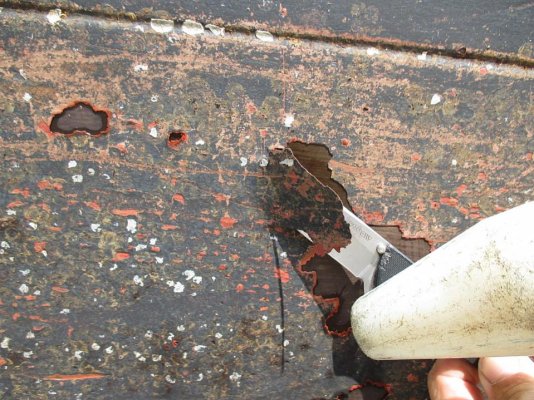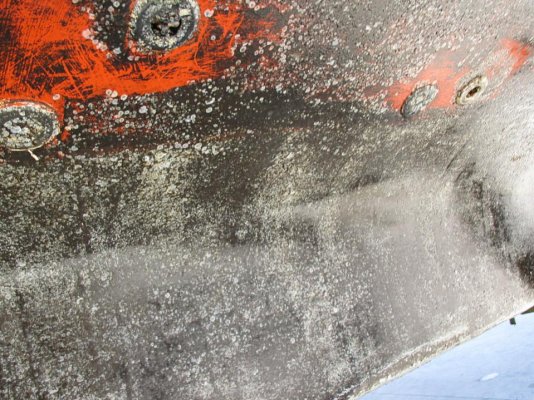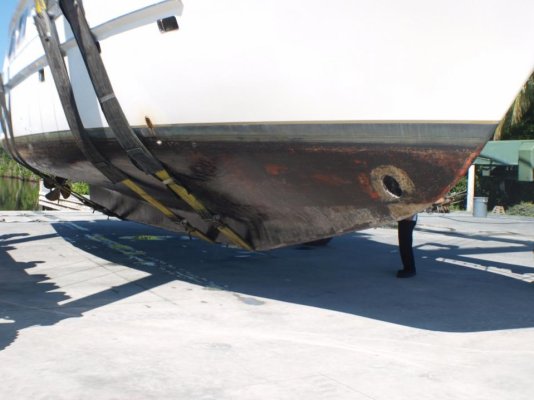You are using an out of date browser. It may not display this or other websites correctly.
You should upgrade or use an alternative browser.
You should upgrade or use an alternative browser.
Bottom paint necessary?
- Thread starter mcrandop
- Start date
The friendliest place on the web for anyone who enjoys boating.
If you have answers, please help by responding to the unanswered posts.
If you have answers, please help by responding to the unanswered posts.
RT Firefly
Enigma
Greetings,
Welcome aboard. If your diver is fine with scraping and is not requesting painting to make his job easier, leave it the way it is. I don't think anti-foul has anything to do with gelcoat preservation other than your diver may damage the gelcoat since he has to scrape harder to remove growth. My .$02.
Welcome aboard. If your diver is fine with scraping and is not requesting painting to make his job easier, leave it the way it is. I don't think anti-foul has anything to do with gelcoat preservation other than your diver may damage the gelcoat since he has to scrape harder to remove growth. My .$02.
menzies
Guru
Have a '77 CHB in Marina in SoCal, never go out. Paint has deteriorated to poor, have been told gelcoat is very thick and not to bother re painting. Have it cleaned monthly.
Never go out or seldom go out? If you never go out, why bother with a diver. Just let the barnacles build up like they do on the docks. A 40 year old boat can't be worth much and will probably go to the scrap heap when you are done with it.
Rather than asking people on the Internet, ask your diver if it needs to be painted. Ask other boaters in your marina what they do. Compare the cost of a haulout and bottom paint job to the value of your boat and how much longer you would like to keep it.
Personally, I leave my bottom paint until my diver starts complaining and then have it repainted. You can take that as advice or not.
Menzies:
Are you saying that marine growth can actually cause delamination of a FG hull? The hull shown looks like FG laminated over wood??
Would not have expected any damage other than increased build-up of marine growth.
A past dock neighbor left the bottom of his Marine Trader 44 unpainted for years. It was a real mess when it was hauled but no permanent damage when he finally decided to paint the bottom and go cruising.
Given the comments about going to the junk yard, and the give-away value of the old boat, why bother to do anything??
Are you saying that marine growth can actually cause delamination of a FG hull? The hull shown looks like FG laminated over wood??
Would not have expected any damage other than increased build-up of marine growth.
A past dock neighbor left the bottom of his Marine Trader 44 unpainted for years. It was a real mess when it was hauled but no permanent damage when he finally decided to paint the bottom and go cruising.
Given the comments about going to the junk yard, and the give-away value of the old boat, why bother to do anything??
"Given the comments about going to the junk yard, and the give-away value of the old boat, why bother to do anything??"
If the boat in question has limited value to the owner and never will run on its bottom and that is OK with the marina then you can ignore all of the following:
- bottom
- running gear
- engines
- genset
- etc
If on the other hand the OP wants the option of going out on the boat some day or selling the boat for some reason then minimal maintenance will be a better path. Pay me now or may me later tends to work in this case.
FWIW - Out here where we are in the NE a boat that cannot move under its own power is very often not allowed at local marinas and will deal with problems associated with that condition.
If the boat in question has limited value to the owner and never will run on its bottom and that is OK with the marina then you can ignore all of the following:
- bottom
- running gear
- engines
- genset
- etc
If on the other hand the OP wants the option of going out on the boat some day or selling the boat for some reason then minimal maintenance will be a better path. Pay me now or may me later tends to work in this case.
FWIW - Out here where we are in the NE a boat that cannot move under its own power is very often not allowed at local marinas and will deal with problems associated with that condition.
tadhana
Guru
- Joined
- Jul 23, 2011
- Messages
- 596
- Location
- USA EAST
- Vessel Name
- Tadhana
- Vessel Make
- Helmsman 38 Pilothouse
As Chrisjs points out that picture is a glass sheathed wood hull, and lightly sheathed at that. It is not a solid fiberglass hull. The chance that having the hull scraped by a diver frequently over many years might wear away the gel coat is just about 0%.
If you never go out why bother with a diver??
Yes - a very good point. It will also avoid the inevitable deep scratches in the hull from excessive scraping and the ever increasing fees from cleaning a really fouled hull.
menzies
Guru
Menzies:
Are you saying that marine growth can actually cause delamination of a FG hull? The hull shown looks like FG laminated over wood??
Would not have expected any damage other than increased build-up of marine growth.
A past dock neighbor left the bottom of his Marine Trader 44 unpainted for years. It was a real mess when it was hauled but no permanent damage when he finally decided to paint the bottom and go cruising.
Given the comments about going to the junk yard, and the give-away value of the old boat, why bother to do anything??
As Chrisjs points out that picture is a glass sheathed wood hull, and lightly sheathed at that. It is not a solid fiberglass hull. The chance that having the hull scraped by a diver frequently over many years might wear away the gel coat is just about 0%.
No, I'm saying that the gelcoat can be eaten through. Not necessarily that the laminate is damaged. Though having the laminate exposed in salt water for years can't be good. Otherwise why would we care about blisters?
2003 Seahorse 53.
From the survey: "Construction is un-cored fiberglass laminate with gelled and cored top sides."
Attachments
Last edited:
markpierce
Master and Commander
- Joined
- Sep 25, 2010
- Messages
- 12,557
- Location
- USA
- Vessel Name
- Carquinez Coot
- Vessel Make
- penultimate Seahorse Marine Coot hull #6
If you never leave the marina and don't care about the boat's bottom condition, then you needn't worry about protective bottom paint.
Donna
Guru
- Joined
- Aug 30, 2016
- Messages
- 1,231
- Location
- United States
- Vessel Name
- Southerly
- Vessel Make
- 1986 Marine Trader 36' Sundeck
Honestly this is really freaking me out. I would never not bottom paint. Worth of a boat is determined by its worth to the owner. Although my boat is a 1986, the work put into her, restoring her is priceless to me. Why would I not bottom paint? I have a diver go down once a month. I just had it painted a month ago.
markpierce
Master and Commander
- Joined
- Sep 25, 2010
- Messages
- 12,557
- Location
- USA
- Vessel Name
- Carquinez Coot
- Vessel Make
- penultimate Seahorse Marine Coot hull #6
Honestly this is really freaking me out. I would never not bottom paint. Worth of a boat is determined by its worth to the owner. Although my boat is a 1986, the work put into her, restoring her is priceless to me. Why would I not bottom paint? I have a diver go down once a month. I just had it painted a month ago.
I'm with you.

psneeld
Guru
I have no idea for sure that paint helps a bottom, or not
In my boats case, it sat in a Ft Lauderdale canal for 25 years....in warm water.
The owner was a dive instructor, so the bottom was rarely painted but often scraped by students.
When I bought tbe boat, tbe bottom didnt appear poor, but adter some grinding, the gel coat looked like swiss cheese, the mat underneath was dry and could be pulled off by hand, and karge sections of laminate were hydrolyzed.
Cant say why the bottom rotted off, but that was its history...one I will never repeat.
In my boats case, it sat in a Ft Lauderdale canal for 25 years....in warm water.
The owner was a dive instructor, so the bottom was rarely painted but often scraped by students.
When I bought tbe boat, tbe bottom didnt appear poor, but adter some grinding, the gel coat looked like swiss cheese, the mat underneath was dry and could be pulled off by hand, and karge sections of laminate were hydrolyzed.
Cant say why the bottom rotted off, but that was its history...one I will never repeat.
Last edited:
markpierce
Master and Commander
- Joined
- Sep 25, 2010
- Messages
- 12,557
- Location
- USA
- Vessel Name
- Carquinez Coot
- Vessel Make
- penultimate Seahorse Marine Coot hull #6
Just how many wood-hulled boat were sunk or given up due to sea worms? More than one can count over the centuries?
FF
Guru
- Joined
- Oct 12, 2007
- Messages
- 22,552
I have seen a large plastic sheet pulled under a stored boat with all the edges pulled above the water.
Clorox or similar was dumped in the created pool and nothing grew on the hull.
For a liveaboard a sink discharge would require a piece of hose to go beyond the pool.
Clorox or similar was dumped in the created pool and nothing grew on the hull.
For a liveaboard a sink discharge would require a piece of hose to go beyond the pool.
Nomad Willy
Guru
I would suggest the hull be spray coated with hot tar its quick and cheap to apply .I know of barges that have been treated this way and it lasts for 5 years
Why???
Is tar that toxic?
Fishermen in Alaska coat their decks w tar. I always just thought in terms of being watertight. But decks on wood boats will grow grass and mould if not maintained.
Last edited:
psneeld
Guru
Studies I have read show some paint does help with preventing water absorption.....doent stop it but it does help slow it.
Paint keeps water from getting to wood quickly so some harder bottom paints do help in my common sense column making the studies seem plausible.....plus personal verifiable experience.
Certainly the thicker and more water migration resistant the coating is, the better the results. A true, properly applied barrier coat is one thing, but a thin, epoxy based paint isnt necessarily nothing.
Paint keeps water from getting to wood quickly so some harder bottom paints do help in my common sense column making the studies seem plausible.....plus personal verifiable experience.
Certainly the thicker and more water migration resistant the coating is, the better the results. A true, properly applied barrier coat is one thing, but a thin, epoxy based paint isnt necessarily nothing.
Last edited:
Deckape
Senior Member
If you don't bottom paint, you will grow everything ,and when you finally pull the boat it will be so much growth that it will cost you / buyer, alot of money to scrap it off and repair the damage to the hull. If you don't take care of your boat ,you don't deserve to own it.
kthoennes
Guru
- Joined
- Oct 11, 2013
- Messages
- 2,473
- Location
- USA
- Vessel Name
- Xanadu
- Vessel Make
- Mainship 37 Motor Yacht
We bought our boat on saltwater, Naraganssett Bay, and the previous owner spent a pile of money on a very good anti-fouling paint job. I thought to myself we were wasting his expensive bottom job by hauling it out to fresh-water Missouri River. Nope, wasn't a waste at all. The boats in our marina develop a pretty thick slime by the end of the summer, and now we're infected with zebra mussels. That ocean-caliber bottom job on our boat makes a huge difference with the slime and the mussels.
So yes, I'd do a good anti-fouling bottom job no matter where I am or how much we run the boat.
So yes, I'd do a good anti-fouling bottom job no matter where I am or how much we run the boat.
Similar threads
- Replies
- 57
- Views
- 10K




